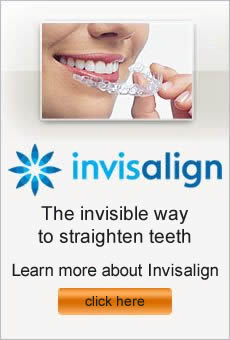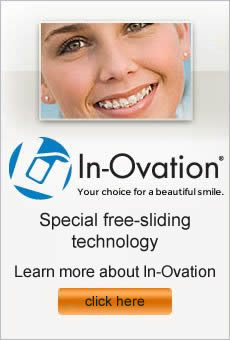Once you decide to improve your smile with orthodontics, it’s a matter of learning which treatment works best for your lifestyle, budget, and dental problems. Two common methods of orthodontic treatment to choose between are traditional metal braces or clear Invisalign braces. Here is a comparison of some important factors about these types of braces to help you decide which might be right for you.
Appearance
Traditional metal braces are very noticeable in your mouth. There is pretty much no chance others won’t notice that you’re wearing them. Invisalign consists of clear plastic aligner trays that are practically invisible. One reason that Invisalign is very popular with adults is the fact that they are not noticeable.
Comfort
The wires and brackets of metal braces may irritate your mouth, so some patients find them uncomfortable. Invisalign trays are made of smooth plastic that rarely causes any discomfort for patients.
Convenience
One well-known fact about traditional braces is that it is hard to keep them clean. Food can easily become stuck in the wires, and brushing and flossing can be difficult. Also, there are a number of foods that you should avoid eating while wearing metal braces because the brackets can break. On the other hand, removable Invisalign trays allow you to brush and floss normally. Since you don’t wear the trays while eating, there are no diet restrictions.
Effectiveness
Although they may not be as attractive or comfortable, traditional braces do a great job of aligning your teeth. They correct teeth that are rotated or crooked, as well as vertically misaligned teeth. They can effectively move teeth to improve your bite and jaw alignment. Invisalign usually has the same outcome as treatment with traditional braces, except in cases of certain problems that aligning trays cannot correct. Invisalign works well on horizontally misaligned teeth, but not as effectively on severely overcrowded or rotated teeth or teeth of varying heights.
Our orthodontists office in Burbank CA offers Invisalign options for teens and adults.
The foods you eat and when you eat them affects your overall health, but also the health of your teeth and gums. If you eat too many foods loaded with sugar, and not enough foods containing important nutrients, your risk of tooth decay increases. How can choosing a smart diet prevent dental problems?
When plaque on your teeth meets sugar, which then causes acid to attack your teeth, your teeth begin to decay. Foods and drinks containing any type of sugar can lead to tooth decay. You should make a habit of reading the nutrition labels on foods, so that you can opt for the choices lowest in sugar. Common sugar-filled items to avoid include sodas, candy, cookies, and pastries.
On the other hand, certain nutrients help build up the health of your teeth and gums. If your diet lacks those vitamins and minerals, the tissues in your mouth will be less resistant to infection. This can lead to gum disease, which if untreated can end up in tooth loss. Experts suggest that gum disease worsens faster in people who maintain a poor diet.
The key is to eat a balanced diet containing the five major food groups: fruits, vegetables, whole grains, lean protein, and low-fat dairy foods. It’s also important to drink plenty of water. You should also limit snacking between meals, because those tend to be foods that fall outside the recommended food items for healthy teeth. Also, more saliva is produced during a meal, which is helpful in cleaning your mouth and reducing the harmful effects of acid on your teeth and gums.
For good dental health, remember to practice proper dental hygiene such as brushing and flossing regularly. Maintaining consistent dental checkups is another way to maintain your oral health. In the meantime, making smart choices in your diet will help keep your mouth in tip-top shape.
Dr. Fotovat is a orthodontist in Sherman Oaks CA
Taking good care of your braces is an important part of the orthodontic process. Whether you’re wearing traditional braces or Invisalign aligners, proper care and maintenance will keep your mouth healthy and your appliances in good condition. Follow these guidelines for optimum results while wearing your braces and obtaining a beautiful smile.
How should I maintain traditional braces?
Traditional braces are known for capturing food particles when you eat, and it can be hard to get rid of all the residue. Brush your teeth diligently after every meal when possible, focusing on each side of every tooth before moving to the next one. Most orthodontists provide a small bristled orthodontic brush made for cleaning braces. There will be areas that your toothbrush can’t reach, but the small brush can access all areas more easily. You can also use a mouthwash to rinse away bacteria and food particles.
How should I maintain Invisalign braces?
One of the main selling points of Invisalign braces is the clear plastic aligners that are almost invisible in your mouth. To help keep them invisible, avoid consuming foods that stain like berries, sodas, grape juice, coffee, or wine. Since you shouldn’t be eating while wearing the trays, it shouldn’t be very difficult to keep staining items away from them. Rinse your aligning trays with warm water after wearing them, and brush the trays gently to avoid scratching or damaging them. Many orthodontists advise using a drop of liquid dish detergent on your toothbrush to clean your trays instead of toothpaste, which may contain abrasive particles. Thoroughly clean your aligners from every angle before returning the trays to your mouth, making sure all soap is removed first. Also remember to clean and rinse your teeth and gums properly before inserting your trays. This will help ensure a healthy and fresh smelling mouth.
Contact our Sherman Oaks orthodontists office for more information.
How do you know when you’ve done something to your orthodontic work that is considered an emergency? Major orthodontic emergencies don’t happen that often, but immediate attention is needed when they do. Less serious issues can usually wait until an appointment. Having some guidelines to explain the difference between types of emergencies is helpful.
Infection
Occasionally a patient’s tooth may become infected after orthodontic treatment. It may not even be related to your appliances, but either way an infection requires professional treatment. If you have pain or swelling near a tooth that continues to worsen, call your orthodontist.
Injury
Accidents can happen whether or not you are undergoing orthodontic treatment. See your orthodontist immediately if you injure your teeth, mouth, or jaw. An X-ray may be necessary to determine the extent of the damage. If your orthodontic appliances are affected, they may require adjustment or replacement.
Minor issues
It is much more common for minor problems to arise with your orthodontic work. Some issues that you can either repair on your own or wait until your next office visit include:
- Poking wire
- Loose wire
- Loose bracket
- Loose elastic band
- Lost or broken elastic band
- Loose appliance
- Headgear that does not fit
- General soreness
Avoiding problems
Most minor orthodontic issues can occur with normal wear and tear. You can help avoid mishaps by steering clear of foods that your orthodontist has warned you about. Hard or sticky items can cause problems. Also, overly vigorous brushing can harm your orthodontics. None of the examples of minor issues should be considered emergencies unless severe or prolonged pain is present.
If you are having an orthodontic emergency, contact our Sherman Oaks orthodontists office.
If you are considering getting braces to improve your smile and the function of your mouth, you might require tooth extractions prior to getting the appliances on your teeth. Your orthodontist may recommend upon consultation that your treatment will be most effective after having some teeth removed. In fact, sometimes tooth extraction is the only way to achieve your goals for orthodontic treatment.
The most common reason for tooth extraction prior to braces is overcrowded teeth, in which space must be created to obtain proper tooth alignment. Doctors often recommend removing the teeth in sets of two or four, taking the same teeth from the top and the bottom at the same time. This helps create a symmetrical smile.
Another problem that can be aided from removing teeth is protrusion, which is when the upper teeth are out too far or the lower teeth are too far back. Tooth extraction can cause needed space to reposition the front teeth and stop the teeth and lips from protruding.
Overbites or underbites also sometimes require tooth extraction. When the upper jaw extends further than the lower jaw (overbite) or the lower jaw extends past the upper jaw (underbite), removing specific teeth can be helpful before moving the remaining teeth into better position. This can help prevent jaw surgery later.
If you and your orthodontist decide tooth extraction is best for you, often you will be referred to an oral surgeon. These specialists are trained to extract teeth with the ideal results and least pain. Usually you can return to your normal activities within a day or two of extraction, while following your doctor’s instructions for eating and oral care. Once your mouth has healed, you can return to your orthodontist to begin your braces treatment.
Braces have traditionally been the way to achieve a beautiful smile, but there’s a new kind of technology available that provides an alternative to metal braces. Invisalign uses a series of clear aligning trays to move your teeth into a better position, while having less impact on your lifestyle and self-confidence.
With Invisalign treatment, you will be custom fitted with trays that fit over your teeth. They are clear, and therefore practically invisible to others. Each aligner is worn for two weeks for twenty hours or more each day. Then you visit your orthodontist to obtain a new aligning tray, and repeat the process. You continue to get new trays every couple of weeks until treatment is complete. The time period for Invisalign treatment varies from patient to patient, but typically the length of treatment is shorter than that of traditional braces.
Invisalign offers some unique benefits compared to traditional braces. Because they are removable, the aligning trays are taken out for meals. Therefore, no food gets stuck like with braces. This also means that oral hygiene is much easier with Invisalign. Your dental care routine is the same as without braces, so it’s simple to brush and floss. Another good thing is that the aligners do not break and there aren’t any wires to break either. Also, the periodic changing of trays does not trigger the amount of soreness that accompanies the tightening of braces. Finally, probably the most popular benefit is that Invisalign trays are invisible, so there is no embarrassment associated with having a mouthful of metal.
As with any type of medical care, the results and specifics of each patient’s treatment varies. Ask your orthodontist about Invisalign and if it can give you the smile that you have always wanted.
Invisalign orthodontist in Sherman Oaks, CA.



